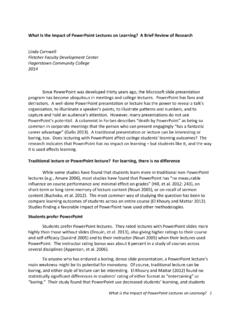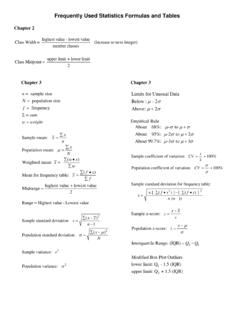Transcription of Echocardiography of Congenital Heart Disease
1 Pediatric EchocardiographySarah Clauss MDChildren s National Medical CenterWashington DCWhat is your career? Echocardiographic Echocardiography and Pediatric of EmbryologyUnderstand Pediatric EchocardiographyCongenital Heart Disease Common lesions Complex lesionsCongenital Heart Defects7-10/1,000 Live BirthsDIAGNOSIS (Balt-Wash)PERCENTV entricular septal defect26%Tetralogy of Fallot9%Atrioventricularseptal defect9%Atrial septaldefect8%Pulmonary valve stenosis7%Coarctation of the Aorta7%Hypoplastic left Heart syndrome6%D-Transposition 5%CHD in Adults30,000 babies born with CHD per year20,000 surgeries for CHD per year85% survive into adulthoodOver million adults with CHDI ncreasing at 5% per year8.
2 500 per year reach adulthoodLess than 10% disabledEvolution of Cardiac SurgeryDiagnosis 1950 s 1960 s 1970 s 1980 s 1990 s 2000 s ASD Rare Repair Repair older child Repair age 4 Repair age 2 Repair age 2-3 Device closure VSD Rare Repair Repair >10 kg or palliate Repair < 1 year or palliate Repair 6 months or prn Repair premature infants PDA Repair Repair Repair Repair Repair TOF Palliate Late Repair in adults Repair after palliation Repair 2-8 months or prn TGA No survivors Rare Survivors Atrial Repair Transitional Decade Arterial Repair Single Ventricle Comfort care Palliate Rare Fontan Fenestrated Fontan Lateral Tunnel Extra-cardiac Fontan HLHS Comfort care Comfort care Surgery in Boston Comfort vs.
3 High risk surgery Surgery & Fetal Diagnosis Embryology 10119 Days: Two endocardial tubes have formed these tubes will fuse to form a common, single primiative Heart tube22 Days: Heart tube begins to beat23 Days: Folding commences30 Days: Primitive circulation 9 weeks (56 Days): All major structures identified(In humans, several months of gestation remain for emergence of HLHS, PS, etc)The Cardiac Crescent and the Tube HeartFrom Heart Development, 1999 Looping and SeptationFrom Heart Development, 199923456 FromDr. do Congenital Heart Defects form?Complex interaction between environmental and genetic etiology Multifactorial 5-8% chance of recurrenceEnvironmental exposures may influence micro-uterine environment and either turn on or off needed protein developmentEcho timeline1793 Italian priest studied bats1845 Austrian scientist Christian DopplerWWII Sonar detected submarines1954 Hertz & Edler (A&B mode echocardiogram)
4 M-mode ultrasound early 1970 s2D echo late 1970 sDoppler Echo 1980 s Pulsed wave Doppler Continuous wave Doppler Color DopplerPediatric Echo is DifferentAnatomy and physiology over function Segmental approach for complex patients Improved resolution Heart is closer to chest wall Higher frequency transducers TEE rarely necessary for diagnosisInversion of apical and subcostal imagesEcho in CHDD oppler echo Pulsed wave Doppler Quantitation of intracardiachemodynamics (Modified BernoulliEquation P= 4 x v22) Valvarregurgitation Intracardiacshunts LVOT/RVOT obstruction Ventricular function Systolic Diastolic (mitral inflow, pulmonary venous inflow)Echo in CHDC ontinuous wave Doppler Non-invasive measurements of mean and peak transvalvar gradients Valvar stenosis Prediction of Ventricular Pressure (modified Bernoulli equation) VSD- LV: RV pressure gradient TR/PR RV, PA pressureDopplerSpectral DisplayPulsed Wave (PW)Continuous Wave (CW)Aortic Valve VelocityRV pressure by TR estimationThe pressure in the right ventricle is 55+ 10= 65mmHg.
5 The pressure in the LV is 83 mmHg; we know it from the blood pressurewhich was 83/61. So, it the RV systemic pressure is of the systemic LV pressure. It means RV systemic pressure is elevated. It should normally be 1/3 in CHDC olor Doppler Direction of cardiac flow TAPVR vs. LSVC Velocity and Turbulence of cardiac flow Conduit obstruction Identification of intracardiac shunts VSD, PDA, ASD Assessment of Post-op CHD Shunt patency, residual intracardiac much time should you spend trying to obtain Doppler of TR when there is a HUGE ventricular septaldefect?
6 If your patient has a single ventricle, if you measure the TR what does that estimate? is it important to Doppler a VSD? you see funny blood flow, should you invert your color scale? doctor wants to know if there is pulmonary hypertension in a NICU baby, but there is no TR, is there another way to answer that question?Classification and Terminology of Cardiovascular AnomaliesMorphologic/Segmental approachDefine morphologic not spatial anatomy Which atrium is the Right? Left? Which ventricle is the Right? Left? Which great artery is which?Define segmental anatomy Segments: Atrium, Ventricles, Great Arteries What is the position of each segment relative to each other?
7 Is the RA on the right? Is it connected to the RV? Is it connected to the PA? Is the LA on the left? Is it connected to the LV? Is it connected to the Aorta?Predict the physiology What is the physiology predicted by the segmental connections? Normal? Transposition? Obstructed flow? What is the physiology predicted by flow in the ductus? Across the foramen?Cardiac base-apex axis and orientation in the chestLevocardia Mesocardia DextrocardiaCardiac situs (sidedness)Example: Cardiac sidednessSitus solitus normal cardiac sidedenssSitus ambiguus, right isomerismDifferentiation between the atriaThe morphologic RA has a smooth or sinusal portion, which is found between the interatrial septum and the crista terminalis.
8 It receives the drainage of the superior and inferior venae cavae and the coronary sinus. The trabecular portion is characterized by the presence of pectinate muscles, which are directed from crista terminalis to the base of the right atrial appendage. The RA appendage is wideand its edge is blunt. RA appendage is broad based and triangularly shaped (like Snoopy s nose), with pectinate muscles that extend into the body of the right anatomic LA is totally smoothand lacks pectinate muscles. It receives the drainage of the pulmonary veins, and LA appendage has a narrow baseand fingerlike appearance (like Snoopy s ears) with pectinate muscles confined within the and TV valve characteristicsRight atrium: Limbusof fossa ovalis(limb of oval fossa) Large pyramidal appendage(Snoopy snose) Crista terminalis(terminal crest) Pectinatemuscles Receives venae cavaeand coronary sinus*Tricuspid valve.
9 Low septalannular attachment Septalcordalattachments Triangular orifice (midleafletlevel) Three leaflets and commissures Three papillary muscles Empties into right ventricle LA and MV valve characteristicsLeft atrium: Ostiumsecundum Small fingerlike appendage(Snoopy sear) No crista terminalis No pectinatemuscles Receives pulmonary veins*Mitral valve: High septalannular attachment No septalcordalattachments Elliptical orifice (midleafletlevel) Two leaflets and commissures Two large papillary muscles Empties into left ventricleDifferentiation between the atriaThe only structures that are constant and allow differentiation between the right and left atria are the appendages!
10 The drainage of the systemic and pulmonary veins does not permit the conclusive identification of the atria, as drainage sites are sometimes anomalous. The atrial septum cannot always be used either, because it can have defects or be ventricle:Tricuspid-pulmonary discontinuityMuscular outflow tractSeptal and parietal bandsLarge apical trabeculationsCoarse septal surfaceCrescentic in cross sections*(* variable)Thin free wall (3 5 mm)*Receives tricuspid valve Pulmonary valveempties into main pulmonary arteryVentricles-characteristicsLeft ventricle: Mitral-aortic continuity Muscular-valvularoutflow tract No septalor parietal band Small apical trabeculations Smooth upper septalsurface Circular in cross section*(* variable) Thick free wall (12 15 mm)* Receives mitral valve Aortic valve Empties into ascending aorta Ventricular features (summary) Features of the morphologic RV: Coarse trabeculae with prominent septal band, parietal band, and moderator band.










